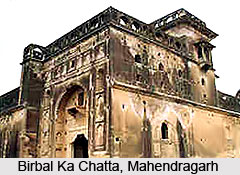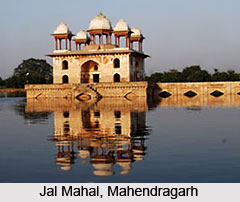 Historical places in Mahendragarh, Haryana are wonderful tourist destinations and are thronged by innumerable tourists every year. They involve some historical structures like Jal Mahal, Chor Gumbad, Birbal ka Chatta, Mausoleum of Ibrahim Khan and others, some of which have been created by ancient rulers or dynasties.
Historical places in Mahendragarh, Haryana are wonderful tourist destinations and are thronged by innumerable tourists every year. They involve some historical structures like Jal Mahal, Chor Gumbad, Birbal ka Chatta, Mausoleum of Ibrahim Khan and others, some of which have been created by ancient rulers or dynasties.
Jal Mahal
This historical building boasts of specially constructed interiors and magnificent architectural patterns. The Jal Mahal was created by Shah Quli Khan in 1591 A.D and the walls of this beautiful palace consist of a contemporary form of architecture. This palace or `pleasure-house` is located in the middle of a gigantic water tank which is presently dry and can be accessed through a causeway. Five kiosks form the foundations of this structure, the larger one based at the centre while the others based at the corners. An arched passage near the palace imparts a unique appeal to Jal Mahal but the garden which was previously a part of this wonderful palace is no longer existent.
 Chor Gumbad
Chor Gumbad
Also known as the `signboard of Narnaul`, the Chor Gumbad resembles a fairytale palace of old legends, owing to its isolated location and haunting appearance. An Afghan known as Jamal Khan was known to have built Chor Gumbad as his tomb. The appropriate date of construction of this historical structure is unknown. However, the arches of Chor Gumbad, which are ornamented with S-curves and other details of the building, suggest that it might have been created during the time when Shah Waliyat`s tomb had been constructed. Though currently, there are graves inside it, Chor Gumbad had been a favourite haunting place for thieves which probably might have lent this structure its present name. Chor Gumbad is a large monument and it possesses a single chamber. From the outside, one might feel it is a double storeyed since one can approach the second level by means of a surrounding verandah. Some architectural characteristics of the Chor Gumbad like wide low domes give an idea that it might have been built during the period of creation of the tomb of Shah Nizam or parts of the nearby Madarsa created in 1357 A.D. Visitors might be amazed by the sudden twists in the passages of Chor Gumbad, and therefore it is known as `Bhul Bhulaiyan`.
Birbal Ka Chatta
Adorned with spectacular rooms, pavilions and halls, Birbal ka Chatta is a five storeyed building which had been built by Ray-i-Rayan Mukand Dass, who was the Diwan of Narnaul during the regime of the Mughal emperor Shah Jahan. Its construction has been planned meticulously. There exists a central court which was once equipped with a marble fountain, elliptical pavilions, beautiful halls and halls on pillars. The marble pillars, cataracts and drains probably imparted a comfortable ambience to Birbal ka Chatta, especially during summers. A well is present on the terrace and water is said to have been released into reservoirs with the aide of a Persian wheel. Tall, projecting balconies, alongwith specially constructed isolated gateways are existent near the western portion of the palace. A legendary tale asserts that four underground tunnels are connected to this palace, which leads to Dhosi, Delhi, Mahendragarh and Jaipur. Since Birbal and Akbar had visited Mahendragarh, the palace is also referred to as `Chatta of Birbal`. There lies the Sarai Mukand Das, at a small distance from the Chatta, which was built by Rai-i-Rayan Mukand Dass, as per the inscription from an epigraph present here.
Tomb of Shah Waliyat
Shah Waliyat`s tomb is located just beside the mausoleum of Ibrahim Khan. Its architectural designs belong to the era which starts from the Tughluq period and continues till the British age. Initially, this tomb and it`s adjoining structures were created during the rule of Feroz Shah Tughluq. A hemispherical dome forms the base of the tomb, which is adorned with ogee curves. The dome is built as per the architectural style followed by Pathans. Paintings belonging to a later period and enclosures belonging to Mughal era are also existent inside the tomb. A portion of the tomb has also been added during the British period.
Mausoleum of Ibrahim Khan
The mausoleum of Ibrahim Khan is believed to have been created by Sher Shah Suri in the memory of Ibrahim Khan, his grandfather. The latter used to work as an officer of the Lodhis, at the region of Narnaul. It is said that the mausoleum was built under Sheikh Ahmed Niyazi`s supervision. Apart from the grave of Ibrahim Khan, there are two other graves inside this mausoleum. This structure is a replica of the square tomb, built in the Pathan style, beautified with exquisite outlines and attractive colour combination. There exist bold arches, turrets, high terrace, low domes, beautifully curved pillars and other magnificent structures in the mausoleum. The red, grey and white sandstone tiles and lapidary add to the beauty of the mausoleum.
Nasibpur
Nasibpur is located about 3 km from Narnaul and at this very region, the Indian freedom fighters had sacrificed their lives and become martyrs, after rebelling against the Britishers, with an aim to achieve freedom for India. To commemorate these brave freedom fighters of the nation, a historical park has been built in Nasibpur. It is said that the blood of numerous freedom fighters had made this land red.
Tomb of Shah Quli Khan
As per the records of Latif`s travelogue and `Ain-i-Akbari`, Shah Quli Khan I had created several beautiful buildings including a mausoleum for him. He made a lovely garden and called it `Aram-Kauser`. However, presently, only a gateway complex and enclosure walls are the only remainders of the tomb. The tomb was built in 1578 A.D. Red and bluish grey stones impart an artistic aura to the ancient tomb, whose octagonal structure reveals its reflection of the Pathan style of architecture. During 1589 A.D., the Tripoli Darwaza was constructed.



















